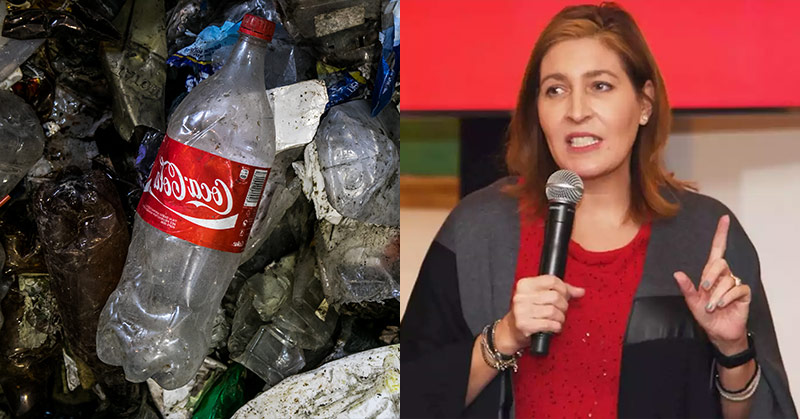Global plastic pollution has become one of the most critical environmental issues we are facing today. This “miracle material” has made modern life possible, but with a vast majority of these products being used only once before being thrown away, they are now overwhelming our ecosystems, clogging our waterways, and killing our wildlife [1].
The problem has become so pervasive that the United Nations has begun to write a global treaty to determine how the issue should be addressed around the world [2]. It has prompted groups of activists across the globe to lobby governments, demanding that there be restrictions placed on single-use plastics, including teens Melati and Isabel Wijsen, who successfully convinced the Island of Bali to ban single-use plastic bags, straws and styrofoam in 2019 [3].
In a recent report by the non-profit Break Free From Plastic, Coca Cola was identified as the largest producer of plastic waste globally for the second year in a row. This, of course, has incited a public outcry from many environmental groups and has prompted a response from the beverage giant.
People Want Plastic
According to Coca Cola’s head of sustainability, Bea Perez, the company will not be getting rid of plastic bottles because consumers still want them.
“Customers like them because they reseal and are lightweight,” she explained [4].
Coca Cola produces about three million tonnes of plastic packaging per year, the equivalent of two hundred thousand bottles per minute. At the World Economic Forum, Perez stated that the firm realizes they need to be “part of the solution”, which has prompted the company to pledge that they will recycle as many plastic bottles as they produce by 2030. They have also stated that they will use at least 50% recycled material in their packaging by the same year, and that the brand will partner with NGOs around the world to help improve collection [4].
Environmental campaigners, however, argue that this will not be enough.
How Does Recycling Work?
There are three basic steps to recycling: Collection and processing, manufacturing, and purchasing.
Step 1: Collections and Processing
Recyclables can be picked up through curbside collection, drop-off centers, and deposit or refund programs. Once they are collected, they have to be cleaned, sorted, and processed into materials that can be used for manufacturing.
It is important to understand as a consumer that recyclables are bought and sold in the same way as raw materials, and the prices will fluctuate depending on demand both globally and in the United States [7].
Step 2: Manufacturing
There are many products today that are made with recycled materials. Newspapers and paper towels, aluminum, glass, and plastic soft drink containers, steel cans, and plastic laundry detergent bottles are all common household items that are often made from recycled materials [7].
When a recycled goog is cheaper or weaker than the original product, it is called down-cycling, or downstream cycling. Gradually, goods move further and further down the recycling stream until they are no longer usable. Paper, for example, can only be recycled so many times before it becomes useless.
Occasionally, products can be up-cycled, which is when they are made into something stronger or more valuable than the original product. An example of this is a company that is turning used plastics into asphalt for roads [8].
Step 3: Purchasing
This is where you, the consumer come in. You help close the loop by purchasing products that are made from recycled materials. By buying products that can easily be recycled or that contain recycled materials, you are helping the cycle to work effectively [7].
The Truth About Recycling
Recycling is a feel-good story that, unfortunately, is too good to be true. This is because most of what you put in your blue bin doesn’t end up getting recycled at all. In fact, according to a research article published in 2017 in the journal Science Advances, only about nine percent of plastic waste gets recycled. Twelve percent gets incinerated, and the remaining 79 percent ends up in the landfill [5].
Another article in Science Advances published in 2010 calculated that 275 million metric tons (MT) of plastic was generated in 192 coastal countries, with 4.8 to 12.7 million MT entering into the oceans [6].
Coca-Cola’s Plans
Perez says that Coca Cola will not be getting rid of plastic water bottles saying it could alienate customers and affect sales. The company’s main focus, then, is on recycling, which many are criticizing as a weak strategy.
Perez, however, is supportive of Coca-Cola’s goals and is calling on the company to reach them before 2030.
“We have to reach this goal and we will – there’s no question,” she said [3].
As a consumer, it is up to you to decide whether or not you agree with the company’s stance, and if you are going to support Coca Cola by purchasing their products or not. As the plastic crisis becomes more and more severe, it is increasingly imperative that consumers hold large corporations and businesses to a higher standard, and demand that environmental preservation is of utmost importance.
- https://www.nationalgeographic.com/environment/habitats/plastic-pollution/
- https://www.nationalgeographic.com/environment/2019/03/un-environment-plastic-pollution-negotiations/
- https://www.bbc.com/news/business-51190449
- https://www.bbc.com/news/business-51197463?fbclid=IwAR2QPEZ4ix5OagwK3ktckHeCJvYeWSQi1zlu1z9b6foHf3KAr-Fl9HfBCWU
- https://advances.sciencemag.org/content/3/7/e1700782
- https://science.sciencemag.org/content/347/6223/768
- https://www.epa.gov/recycle/recycling-basics
- https://science.howstuffworks.com/environmental/green-science/recycling.htm

